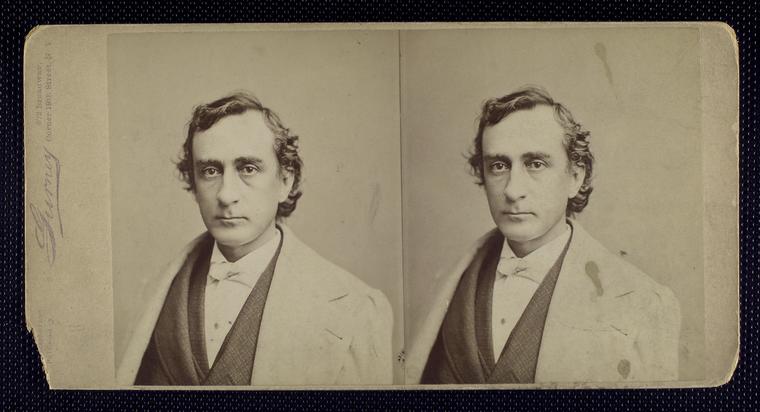Archives
The Stereograph Headshot
When we started to think about an exhibition on Head Shots based on the Library for the Performing Arts’ collections, we discovered that almost every format in the history of photographic portraits was used as a headshot. Not, despite the title, daguerreotypes, but almost everything with a reproducable negative since then. The one format that we did not expect to find was stereograms (also known as stereographs) since we believed that most such double images showed landscapes or “scenes.” We didn’t expect stereograph headshots because we didn’t expect stereograph portraits.
Stereographs are two images of slightly differing depth, angle or scale which, when viewed simultaneously with special lenses reveal a single three-dimensional result. Stereoscopes were invented independently of photography (c. 1838) and could be used with engravings and other forms of printed image. Essayist Oliver Wendell Holmes, writing about “The Stereoscope and the Stereograph” in the Atlantic Monthly (June 1859), referred only to “squinting magnifiers” that could be used to see more lifelike images of landscapes and other “views.” Most of the lengthy article equates stereographs with landscapes, natural and with buildings, made “solid.” Holmes warned against what he called “groups,” scenes populated with “vulgar models, shamming grace, gentility and emotion by aid of costumes, attitudes, expressions, and accessories.” The full essay is reprinted in Beaumont Newhall’s On Photography (1950) and in Photography in Print, edited by Vicki Goldberg (1981).
If you search Stereograph in the Digital Collection, you will find a collection of landscapes and scenes, primarily from the later 1800s. They show Africa, the Caribbean, and the U and include what are catalogued as “ethnic types” and Holmes would call "groups." Two large sections are from series distributed by Universal Photo Art Co., 1901, or Keystone View Co., 1900.
The “headshot” stereographs, all from the Library for the Performing Arts’ Billy Rose Theatre Division, seem to be from the 1870s, based on the garments worn. They are credited to the NYC photographic studios that actors preferred for their portraits—Sarony, Falk, Gurney, Mora, etc. There are two general categories. Some, like the Edwin Booth example, are stereographs made at the same session as more conventional cabinet photos. The Booth collection includes examples of those formats for this image by J. Gurney & Son, NY. Booth also had J. Gurney cabinet photographs and stereographs in costume for Hamlet. In other examples (including the Kate Claxton photographs on display in Head Shots), the cabinet photographs are mounted by the original photographer, but the Stereographs are mounted and distributed as part of a Celebrity series.
Read E-Books with SimplyE
 With your library card, it's easier than ever to choose from more than 300,000 e-books on SimplyE, The New York Public Library's free e-reader app. Gain access to digital resources for all ages, including e-books, audiobooks, databases, and more.
With your library card, it's easier than ever to choose from more than 300,000 e-books on SimplyE, The New York Public Library's free e-reader app. Gain access to digital resources for all ages, including e-books, audiobooks, databases, and more.
If you don’t have an NYPL library card, New York State residents can apply for a digital card online or through SimplyE (available on the App Store or Google Play).
Need more help? Read our guide to using SimplyE.
